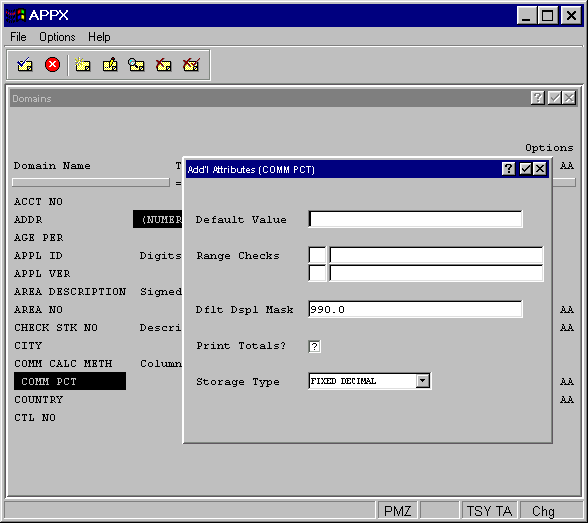
Numeric Domain Additional Attributes
From the Numeric Domains overlay, the additional attributes option accesses the Additional Attributes overlay shown in Figure 2-3-17 below.

Figure 2-3-17. Numeric Domain Additional Attributes Overlay
The numeric domains Additional Attributes overlay contains the following fields:
· Default Value establishes a value for all referenced fields whenever they first display an input image in add mode, unless modified by a user. If blank, the starting value is assumed to be the null value.
· Range Checks defines a series of allowable values that APPX uses for online data validation. The first component represents the relation. The options are EQ (equal to), NE (not equal to), GT (greater than), LT (less than), GE (greater than or equal to), LE (less than or equal to), IN (includes).
The second component represents the value assigned to the relation. If you enter two relations, APPX infers an AND relationship.
· Dflt Dspl Msk controls how fields based on this domain appear on an APPX image to a user (unless overridden at the image item level). If blank, APPX uses a display of non-fixed leading spaces with one significant digit.
· Digits to the left of a decimal are leading digits.
· Digits to the right of a decimal are trailing digits.
· Leading zeros refer to zeros that are to the left of the far left-hand leading digit.
· Trailing zeros refer to zeros that are to the right of the far right-hand trailing digit.
There are six types of characters that you can use on a numeric mask: digit placeholders, decimals, group characters, sign characters, currency symbols, and alignment characters, as described in a later section.
· Print Totals? indicates whether fields based on this domain
should be automatically totaled on reports. Click the checkbox to toggle
between yes ![]() and no
and no ![]() . This entry
is used as a default for the auto-total specification in output and inquiry
process definition.
. This entry
is used as a default for the auto-total specification in output and inquiry
process definition.
· Storage Type determines the internal storage format for all fields that reference this numeric domain. The Storage Type options are:
BINARY The number is stored in binary form. The high order bit determines the sign: on or 1 for positive, and off or 0 for negative. The decimal position is established by the Decimals Left/Right entries.
FIXED DECIMAL employs a packed decimal format that stores two decimal digits for each byte with the exception of the last bit, which is the sign bit. The decimal position is established by the Decimals Left/Right entries.
FLOATING DECIMAL employs a combination of binary and packed decimal formats that always requires a total of nine bytes of storage. The first 15 digits are stored as packed decimal with two decimal digits for each byte (for a total storage requirement of eight bytes). The final byte (binary) determines the maximum number of digits that currently appears to the right of the decimal.
The default is FIXED DECIMAL. For a comprehensive discussion of these options, see Numeric Storage Types.